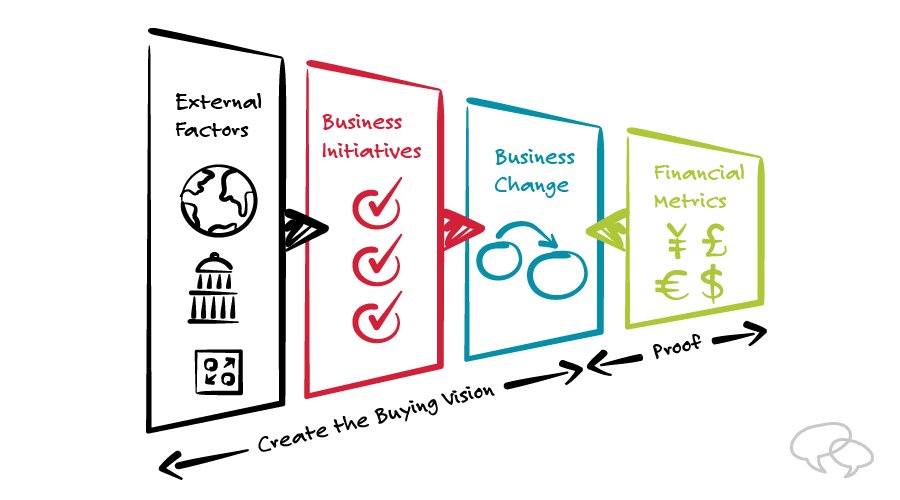
Confidence and competence. All too often, that’s what salespeople lack when selling to the C-suite and other financial decision-makers.
In fact, Corporate Visions research found that most companies aren’t satisfied with their ability to tell an executive-level story.
- 67 percent say they’re underperforming at getting executive-level prospects to buy now rather than later.
- Only 39 percent are confident in their ability to build a meaningful business and financial case to justify a decision.
These are big issues, considering that 80 percent of your deals will require a VP or higher-level signoff. Without executive buy-in, your deals stall, you lose momentum, and your close rates plummet.
But dig a little deeper, and you see that stalled proposals and lost deals are the symptoms of a value communication problem. Sales reps lack the competence and the confidence to elevate the conversation, create enough urgency, and show enough business impact to persuade executive buyers to make a decision now.
So, how can you overcome this “fear of heights” when you’re selling to the C-suite?
Elevating Your Sales Conversations for the C-Suite
When you’re sitting across from a CXO, you only get one shot to pique their interest. If you don’t come to the table with enough knowledge and insight, they’ll shut you down without a second thought, and you won’t get another opportunity.
Demonstrating competence does not mean competence in your own business. It means being perceived as competent in your prospect’s business. Enterprise sellers get delegated to who they sound like. So if you want to win over C-suite buyers, you need to show competence in their business, at their level.
To make it happen, you need to take the Buyer’s Perspective and achieve what I like to call, “I know that you know that I know.”
In other words, the executive decision-maker needs to understand that your head is inside their business—not the product or service you want to sell them.
Here’s how you do it.
A Proven Formula for Selling to the C-Suite

1. Highlight External Factors
External Factors are out of the control of your C-level decision-maker. They might be regulatory changes, tariffs, interest rates, geopolitics, oil prices, technology changes, and so on. It’s literally what keeps executives awake at night (but please, don’t ever ask any executive that question).
External Factors are critical because it’s where you can communicate the most value—it’s where both the problem and the solution are unknown. So, start each of your executive conversations with a few External Factors that are out of their control to establish your credibility in the first couple of minutes of the sales conversation.
2. Identify Business Initiatives
Your prospect’s business initiatives, or “strategic initiatives,” are often shaped by External Factors. These are essentially the major drivers of the company. Are they trying to increase share, grow revenue, cross-sell/upsell, expand into new markets, grow through mergers and acquisitions? You need to identify what their strategic initiatives might be.
Check out this 20-minute cheat sheet for making your executive conversations more insightful.
3. Introduce Unconsidered Needs
Executives are always looking for an edge. Telling an executive something they already know doesn’t create that edge or bring any value. By introducing Unconsidered Needs, you’re amplifying a missed opportunity or a problem they’ve underappreciated or didn’t even know about. That’s how you create urgency and differentiate yourself.
What is an Unconsidered Need? Think of it this way: You’re telling your C-level decision-maker something they didn’t already know about an opportunity, problem, or risk they didn’t know they had.
Sometimes you can’t challenge the executive’s strategy, but you can challenge their certainty by introducing a risk. And risk is one of the few subjects that doesn’t get delegated down. When you bring in a risk, you light up the executive’s brain to think more carefully about what they don’t already know.
4. Provide a Solution Story
You’ve shown that you understand the External Factors that shape and create your buyer’s strategic business initiatives. But what is the future state? How can you help them resolve the Unconsidered Needs you identified and get to that future state? The connection between their current state and their future state is your Solution Story.
The Solution Story creates a Buying Vision—the vision of where you want to lead your buyer. And you’ll likely need to use financial metrics in the process. Executives need financial proof to underpin that Buying Vision.
5. Quantify the Business Impact
Even at an executive level, decisions are made subconsciously in less than the blink of an eye. Then the rational, analytical part of the brain takes over to justify the decision. That’s the part that responds to logical information like ROI.
Quantitative results and ROI don’t drive executive decisions. Still, they are useful as a tool for the decision-maker to explain their decision to others and to justify it to themselves in the process, priming them for action.
The ROI calculation you use should be specific to your customer. It might be return on sales. It could be return on capital. You need to do a little research. Look at their annual report, read an earnings call transcript, and understand how the C-suite is being measured.
Conclusion
When selling to the C-suite, you need to elevate your conversation and teach them something they don’t already know about their business.
Create a compelling Buying Vision, illustrate how your solution can resolve their previously Unconsidered Needs, and how you can ultimately help them realize their strategic goals.
Watch my recent webinar, Toe to Toe with the CXO, to discover even more sales strategies and CXO insights for improving how you sell to C-level executives.





